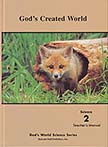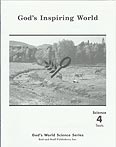| Astronomy |
Sun (size, ball of fire, closest star; affects seasons and day and night) Moon (earth's closest neighbor; reflect sunlight; no air, water, or life; craters; dark side cold; shapes [phases]) Stars (far away, make their own light; different sizes and colors; Big and Little Dippers, Milky Way, North Star, Orion, Seven Sisters) |
Revolution of earth around the sun Seasons caused by tilt of earth Days per year Phases of moon Tides |
Stars
Constellations
Movement of Uses of star guides |
Galaxies Light years Nebulae Stars: binary, distance, magnitude, number |
Eclipses Solar System: asteroids, comets, meteorites, moon, planets, sun Stars |
|
Astrology, zodiac, ecliptic Aurora, nova, nebula Declination, right ascension Equinox, solstice, sidereal day God's purpose of the stars Identifying stars and constellations Light-year, parallax, retrograde motion, solar eclipse map Stargazing helps and equipment Types of galaxies |
|
|---|
| Earth |
The four seasons (length of days, temperatures, life) Weather (clouds, fog, rain, wind, blizzard, tornado, hurricane) Water (importance; water cycle; vapor, evaporation, drought, rain; flood) Soil (topsoil, subsoil, bedrock; minerals; loam; organic matter, clay, silt, sand) Rocks (mountains; quarry, mines, ore; marble, granite; uses) |
Floods Rain Climates Summer and winter |
Climate Weather: wind, cyclones, hurricanes, tornadoes, thunderstorms Fronts Precipitation |
Earthquakes: detecting, faults, tsunamis Mountains: climate, folded and fault-block, volcano Oceans: waves, currents Storms: thunderstorm, tornado, hurricane Water cycle Waterfalls, hydroelectricity Weather patterns: air mass, climate, front, jet stream |
Atmosphere: composition, layers Climate to support life Nitrogen cycle and water cycle Oceans: currents, support for life Oxygen-carbon dioxide cycle Resources: energy, water, wind Soil, nutrients, percolation, aquifers Waterfalls, hydroelectricity |
Aquifers Atmosphere: troposphere, stratosphere, ionosphere, magnetosphere Creation vs. evolution Earth layers: core, mantle, crust Environment, balance of life Resources: mineral, fuel, nonrenewable, renewable Ocean currents Smog, acid rain The Flood, fossils Topsoil, nutrients
Water cycle |
Climate, meteorology, global wind systems, Coriolis effect, pressure ceils, El Niño Convectional, orographic, and frontal lifting; cloud types; warm, cold, and occluded fronts Geyser, ocean currents Relative humidity, dew point Thunderstorms, hurricanes, tornadoes |
Minerals Ore Ozone |
|---|
| Physics |
|
Temperature: cold and heat Conduction, convection Contract—expand Color, rainbow Buoyant force, water pressure 6 simple machines States of matter |
Light: shadows, spectrum, reflection, refraction Concave and convex lenses Electricity: sources, appliances
Conductors, insulators
Circuits, switches, resistance
Electromagnets |
Kinetic and potential energy Measuring work, mechanical advantage, effort Natural laws Air and water pressure Resistance: gravity, inertia, friction, molecular attraction Simple machines: lever, incline plane, screw, wedge, pulley, wheel and axle Sound: waves, pitch, volume, resonators, absorbing |
Buoyant force, airfoil Electricity, magnetism Energy chain: law of conservation of energy, law of thermodynamics Generating and harnessing energy Kinetic and potential energy Renewable and nonrenewable sources of energy Transportation |
Airfoil Fluids: water pressure, atmospheric pressure, buoyant force, partial vacuum Gravity: law of universal gravitation, center of gravity, weight, scales, density of materials Heat, friction Sound: wavelength, speed, echo, volume, decibel, resonator, insulator, pitch, music, frequency, chord, noise |
Acceleration, momentum, action, reaction, laws of energy Centrifugal and centripetal force Temperature, entropy, calories, Btu, radiation, pressure Insulation, latent and specific heat, expansion, conduction, convection, condensation, sublimation, evaporation |
Atom, fission, fusion, neutron, proton, shell, subshell Energy: atomic, chemical, geothermal, harnessing, light, kinetic, potential, solar, tidal Electricity, electromagnetism, spectrum, electrolysis, induction, magnetism Metallurgy, alloy, annealing Molecular attraction Principles of light: absorption, interference, polarization, radiation, refraction, reflection Photoelectric effect Quantum theory Speed of light Work, efficiency, foot-pound, force, friction, mechanical advantage, resistance |
|---|
| Chemistry |
|
Properties of water Materials with special properties Properties determine use
Wood
Pitch |
|
Acids and bases, pH scale Atoms and molecules Benefits and problems with chemicals Chemical formulas Chemical reactions Elements and compounds Fire: building, controlling, fuel, kindling temperature Physical vs. chemical changes Synthetic materials |
Atoms, molecules, compounds Capillary action Carbohydrates, photosynthesis Enzymes Nitrogen cycle: nitrates, proteins Oxygen-carbon dioxide cycle pH scale Solvents |
Burning, ignition temperature, extinguishing fire Chemical reaction, catalysts, oxidation Class A, B, and C fires Combustible materials Fuels, hydrocarbons Oxygen/nitrogen air ratio Photosynthesis, capillary action Soil pH |
Carbohydrate: cellulose, starch, monosaccharide, disaccharide Elements, compounds, formulas, symbols, suspensions, solutions, solutes, solvents, alloys Surfactants, fat-soluble and water-soluble vitamins, major and minor minerals, proteins, amino acids, enzymes, hormones |
Acids & Bases Bonds: covalent, ionic, metallic Chemical formula Chemical symbol Electrolyte Elements, electron, isotope Compound, organic compound Molecule Nitrogen fixation Oxide, galvanize Periodic table pH scale Reactions (combination, decomposition, replacement), catalyst Valence |
|---|
| Biology |
Plants (parts; seeds; vegetables; flowers; annuals, perennials) Trees (parts; broadleaf and evergreen; uses: windbreaks, shade, nesting places, lumber, paper, fruit, nuts, chocolate) Birds (parts; life cycles; nests; food; instinct, migration) Kinds of animals (farm, wild, zoo, insects, bees, spiders, frogs, reptiles) |
Land animals: reptiles, amphibians, mammals Plant survival
During flood
During winter Hibernation, migration Balance of nature |
Zoology: birds, fish, mollusks Botany: cells, propagation, grafting
Seed-producing plants
Roots, stems, leaves, flowers, fruits, seeds |
Alternation of generations Arachnids: structure, spider webs Crustacean: structure Crustacean: structure Ecology, food chain Insects: structure, life cycle, collecting and mounting, harmful and helpful Photosynthesis, fermenting, cell fission Plants with seeds: algae, mosses, ferns, bacteria, molds, mushrooms, yeast |
Balance of life Ecology Food chain: predators, prey, scavengers Hydroponics vs. soil Photosynthesis Symbiosis |
Agriculture and living soil Cell: membrane, chloroplast, nucleus (chromosome, DNA, gene), cytoplasm (mitochondria, tubule, ribosome, Golgi complex, vacuole, granule) Function vs. structure God, the source of life Kingdoms of monera, protista, fungi, plants (moss, fern, conifer, monocot, dicot), and animals (rotifer, sponge, mollusk, worm, arthropod, vertebrate) Life: characteristics (stimuli, growth, reproduction, death) Man |
Flexor and extensor muscles, fat, melanin, phases of the heart Lymph, spleen, thymus, tonsil Neuron, dendrite, axon, synapse, cerebrum and lobes, cerebellum, brainstem, reflex action, senses, interneuron, organism Pancreas, liver, ileum, jejunum, duodenum, colon, appendix Pituitary, thyroid, parathyroid, and adrenal glands; pancreas Platelets; antibodies, antigens |
Chromosome Dominant trait Embryo Gene Heredity Hybrid Law of dominance Law of segregation Meiosis Mitosis Mutation Pollination Recessive trait Zygote |
|---|
| Body |
|
Skin Hair Nails |
Immune system Disease symptoms White blood cells Antibodies Eye |
Digestive tract Ear: inner, middle, out Larynx Muscles: diaphragm, skeletal, cardiac, smooth, voluntary vs. involuntary Nervous system: brain, spinal cord, nerves Skeletal system: kinds of joints, supportive and protective bones, cartilage and ligaments |
Circulatory system: blood vessels, heart, plasma, red corpuscles, white corpuscles Digestive system: intestines, saliva, stomach, villi Respiratory system: diaphragm, lungs, nasal passages Sensory system: nervous system, sense organs, skin |
Ear: canal, cochlea, malleus, incus, stapes, Eustachian tube, eardrum, semicircular canals, auditory nerve Immune system: skin, mucous membrane, tears, coughing, sneezing, stomach acid, white blood cells, antibodies Voice: larynx, vocal cords, articulators |
Systems: circulatory, digestive, endocrine, excretory, integumentary, lymphatic, muscular, respiratory Consciousness, memory, emotion, REM and non-REM sleep Nervous system: central, peripheral, autonomic, sympatheci, parasympathetic Skeletal system: appendicular and axial, joint type, bone repair |
Eye |
|---|
| Health |
|
Posture Exercise Cleanliness Food
4 groups
Calories |
Deficiency diseases Vitamins, minerals Balanced diet Diseases: germs, immune system, vaccines Medicine, antiseptics, sanitation Eye safety Electrical safety |
Antiseptics and sterilization Chemical safety: antidote, ventilation Ear care First aid Harmful bacteria Posture and exercise Safety-consciousness |
Antiseptics First aid Maintaining healthy digestion Skin care |
Acute, chronic, recurrent disease Doctors diagnosing and treating Infectious diseases: bacteria, viruses, fungi, parasites Incubation, acute, convalescent Noninfectious diseases: allergic, degenerative, nutritional, hereditary, and cancerous Rules of personal hygiene, ear care Sanitary living: food preservation, pasteurization, water purification, sewage disposal Sterilization, antiseptics, vaccination, quarantine |
Food guide pyramid, deficiency, disease, diet, posture, hygiene, sanitation, exercise, teeth care First aid (A-B-C-D-E; RICE; CPR; hypothermia; drowning; choking; fainting; shock; body carry; wounds; sprains; strains; fractures; burns [electrical, thermal, chemical], poisoning [internal, respiratory, stings, skin, bites], safety [skin, eye, power equipment, ladder, respiratory, electrical, chemical]) |
Care of eyes |
|---|
| Technology |
|
Boats Agriculture
Seedtime and harvest
Cultivation Wheel Windmill Water wheel |
Observatories Calendars Concave and convex lenses Telescopes, microscopes, sextants Circuits and safety switches
Batteries, generators
Incandescent lights
Fluorescent lights |
Barometer, seismograph, telescope Chemical test paper Fire extinguisher Hydroelectricity, turbines Pumps: centrifugal, gear, piston Reducing friction, bearings Scientific experiment Simple machines, block-and-tackle Sounding board |
Airplanes, cars, ships, turbines Communication: amplifier, loudspeaker, microphone, telegraph, telephone Electricity: circuit breakers, circuits, lamps, magnets, motors, relays, transformers Engines: four-cycle, jet, steam Solar cells Transmission, clutch, brakes, fuel injector, carburetor |
Acoustics, megaphone Altimeter, barometer, hydrometer Catalytic converter Doctor's instruments, MRI and CAT scans Fire extinguisher, lighter-than-air balloon Modern farming methods, pesticide application Pendulum, pitch pipe and tuning fork Pumps and siphons, septic systems Scales: balance, spring, electronic |
Optics (binocular, telecope), planetarium and orrery Distillation (fractional, destructive), refrigeration (gas, electrical), pressure cooking, heat lamp Gyroscope, navigation, eclipse forecasting, scales (hurricane, tornado), wind chill and heat index Thermometer (thermistor, infrared, bimetal, thermocouple, glass) Weather forecasting, barometer, hygrometer, psychrometer, anemometer, weathervane, weather map, and computer |
Communication Computer systems |
|---|
| Stewardship |
|
Welfare of animals Man a caretaker Man's abuse of earth
Sin (before the Flood)
Drunkeness (Noah)
Pride (tower of Babel) |
Hygiene Eye care and use Electrical safety Pruning |
Accident prevention Avoiding waste Diseases prevention Ecology, pollution Reducing friction |
Balance of nature Care of the body Conserving energy sources Cultivation of soil Ecology God as Creator and Owner Inhabiting the earth Renewable and nonrenewable resources |
Balance of nature, ecology, conserving energy sources, controlling air pollution Crop health: seeding, pest control, inspection, nutrition Fire prevention: common sense, resistant materials Four R's: reduce, replace, reuse, and recycle God as Creator and Owner Christian farm management Livestock health: housing, cleaning, feeding, nutrition Protecting, testing, and fertilizing soil Scientific attitude and method |
Exercise, nutrition, food guide, pyramid, diet, temperance Proper use of the body and the mind, respect to God-ordained laws of nature, teeth care Safety and prevention, shields on power equipment, speed limits |
Safety
With chemicals
With electricity
With machinery Spiritual light |
|---|























